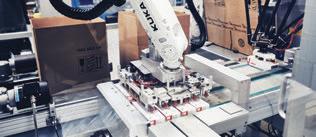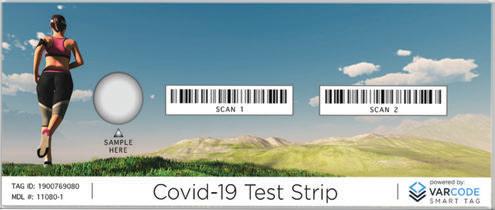
13 minute read
AUTOMATION
↖ Young Living sells 5 and 15 mL bottle sizes with screw caps. Credit: Young Living
Hitting Essential Filling Speeds for Essential Oils
AARON HAND, EDITOR AT LARGE
1. Young Living chose a pharma-grade filler for speed and reliability.
TOP THREE TAKEAWAYS
2. Time savings also come through automatic recipe functions. 3. The system was customized for screw caps instead of standard vial stoppers.
Nutraceutical companies might be getting called out by pharmaceutical companies these days to follow the same sorts of guidelines that they’re held to, but the key reasons a leading essential oil maker went with a pharma-grade filler had a lot more to do with speed and reliability. “I’d recommend Bosch if they were filling 5 and 15 mL bottles of anything,” says Trent Davies, facilities and maintenance manager for Young Living.
What the FLC 3080 TR-EO filling machine from Syntegon Technology (formerlyBosch Packaging Technology) provides for Young Living is stainless steel construction that’s easy to clean, won’t corrode from the essential oils or cleaning agents, and is easy to access.
It also offers a throughput that’s three times as fast as what Young Living was getting from its previous fillers.
Young Living’s four monoblock filling/capping machines can each output 90-100 bottles/min. In contrast, the Syntegon filler runs at a speed of 300 bottles/minute for both the 5 and 15 mL bottle sizes that Young Living sells. The Syntegon system starts with its standard pharma-grade FLC 3080 but is modified for screw caps rather than the usual rubber stopper finish.

↑ The FLC 3080 TR-EO filling machine is an eight-head piston pumping system. Credit: Syntegon Technology
For standard pharmaceutical vials that are stoppered and crimp capped, Syntegon makes machines that can fill at speeds of 30/ minute to more than 600/minute. “When Young Living came to us with these screw caps, the challenge was can we still maintain the high rates of filling but also the screw capping,” says Mark Schwartzbauer, applications engineering manager—pharma liquid for Syntegon.
Syntegon has been making 300+/minute fillers that do screw capping for well over 20 years—putting screw caps on saline solution bottles, for example, for companies like Alcon and Bausch + Lomb. In this case, however, the cap also included a built-in dropper inside it, creating an added challenge.
The speed was an important aspect of what Davies was looking for in operations at Utah-based Young Living, which was seeing significant growth in the essential oils market. Aromatherapy pickme-ups and relaxation are just the tip of the iceberg for essential oils. They’re used in home products for safer cleaning supplies, in nutritional supplements, as flavoring in foods and beverages, and in a wide range of personal care products. With an expansion of food and beverage industries and added health benefits of essential oils expected to boost their use in pharmaceutical and medical applications, the market is poised for growth. A growing consumer preference for natural and organic products is expected to boost essential oil sales to more than $11 billion by 2022, according to Allied Market Research, with a CAGR of 8.7% from 2016.
Keeping up with demand
As a leader in essential oils, Young Living passed $1 billion in sales in 2016. With demand continuing to rise, their existing filling and labeling equipment just couldn’t keep up. Not only was Syntegon able to deliver the high-speed equipment that tripled the output of the 5 and 15 mL bottles, but it incorporated the other advanced technologies that Davies was looking for as well. “The technology on this line is head and shoulders above our old lines; it’s not even close,” Davies says, pointing to the FLC’s servo technology, advanced human-machine interface (HMI), and batch data reports. “The comparison of the HMI alone—it gives so much more information than our other ones do.”
As an example of what can be done with the batch records, Davies notes how cap torque history had previously been done manually— now saving staff hours by getting those reports through the batch records. “[This] allows the manufacturing manager to do his reviews on what is going on with the machine throughout the day or through the week,” he says. “So if he has customer complaints, like if there’s a complaint of a leak, he can find out almost instantly, on that day, if it came off the Bosch or not.”
A typical batch data report captures all the pertinent information of a production run, Schwartzbauer notes. “It would capture

↑ Customizing the pharma-grade FLC 3080 for screw caps instead of standard vial stoppers created some challenges for maintaining high throughput, but Syntegon was able to provide speeds of 300 bottles/ minute. Credit: Syntegon Technology

↑ The HMI on Syntegon’s filling and capping machine gives much more information than those of Young Living’s other fillers, according to Davies. Credit: Syntegon Technology
any alarms, any stoppages of the machine, it captures all the recipes when things were set up or things were changed, but it also captures things like rates of the vials,” he says. “We also have a statistical checkweigh, so we’re monitoring the weights for sampling of the bottles that are going through. We’re capturing the torque data; we’re also capturing good vials vs. rejects.”
Time savings also come through automatic recipe functions, notes John Augsburger, regional sales manager—pharma liquid packaging for Syntegon. “You have the ability to save and create new recipes that you can just load at the touch of a button,” he says. “It recalls the last parameters you used for that particular product and that particular vial size. So everything is in the machine; you do not have to set up the machine over and over and dial it in.”
Return on investment
The FLC 3080 TR-EO filling machine is an eight-head piston pumping system with statistical checkweigh, 16-head rotary screw capper, and cap vision inspection with reject station. The line uses a third-party labeler, which was sourced and integrated by Syntegon. Though the benefits over its other four fillers might seem clear, Young Living did not take the purchase decision on the FLC 3080 lightly. “It was a big jump for Young Living in terms of output and
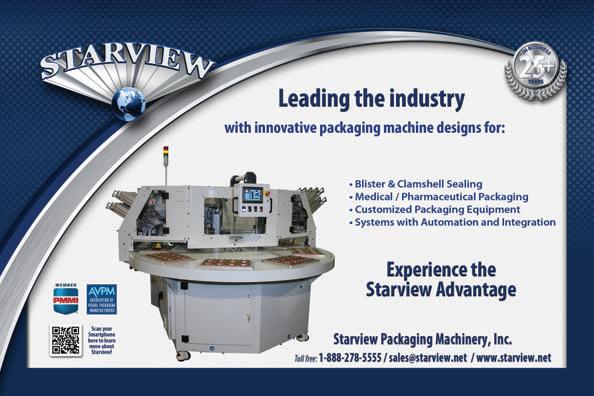
yield. But it was also a big commitment in terms of investment compared to what they were used to paying for a filler,” Augsburger says. “It’s not something that would be easy to justify if you were an engineer trying to sell it internally.”
In fact, Young Living is in the process of starting another filling project with Syntegon, Davies says, though he’s not ready to share any details at press time.
From Davies’ perspective, the service from Syntegon also plays heavily into his satisfaction. “I’ve had a long history of dealing with startup equipment and dealing with problems. My opinion is that [Syntegon] went over and above what I’ve seen a lot of machine manufacturers do on some of our problems as far as accepting costs and working stuff out with us and timelines and meeting deadlines,” he says. “They were very, very proactive.”
For the latest in filling machinery, make plans to visit the virtual PACK EXPO Connects, Nov. 9-13. For more information visit www. packexpoconnects.com
Tampons in an Ice Cream Pint Make a Whimsical Statement
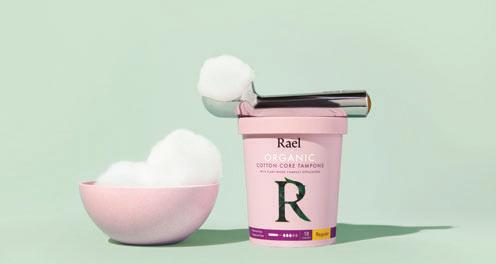
KEREN SOOKNE, DIRECTOR OF EDITORIAL CONTENT
1. Rael sought a unique secondary package for their newest SKU in personal care.
TOP THREE TAKEAWAYS
2. They selected a recyclable paperboard pint, with manual filling operations. 3. One challenge was finding the perfect size pint to hold the 18-count quantity.
Feminine care brand Rael is a startup founded in 2017 by three Korean American women who wanted to bring wellbeing to women’s lifestyles, offering products free of harsh chemicals. “Because we grew up in Korea, we grew up using Korean feminine care products, which we found are higher performing and more comfortable,” says CEO Yanghee Paik.
The women all came from various work backgrounds and learned about the personal care market as they went. “I used to be a movie distributor at the Walt Disney Studios,” explains Paik. One cofounder is a designer and the third, a best-selling writer on empowerment and female leadership.
Beginning with feminine pads and liners—which Paik says are more popular in Korea—they were focused on using high quality ingredients, opting for organic cotton from Texas. “In this space, it’s a big advantage that we are female-founded and that we knew exactly what we wanted as consumers ourselves. That really helped a lot to get the product right,” she notes.
Their first product line was successful. Three to four months after launching on Amazon, they became the number one brand in the segment. They knew the tampon market was big in the U.S. and branched out. “After getting some strong VC backing, we launched our B2C sites and then our big mission was to secure a brick and mortar distribution channel” to catch consumers passing by and make it easy for them to repurchase.
Rael secured a deal and began selling in Target stores in 2019. In addition to pads and tampons, they began producing hygienic wipes, heating pads, and skincare.
With two tampon SKUs on the market—a long applicator and
a cardboard applicator both in traditional then it was a pretty smooth process,” Paik cartons—Rael wanted fresh packaging for explains. their new compact tampons. The tampons are produced and packWhimsical look currently packed by hand instead of in an
“With this third launch in the tampon automated process. “That’s another chalfamily, we wanted to do something very lenge, but it’s a sacrifi ce that we made in unique. You think about who is using this order to make this package happen. I’m glad compact tampon. It’s a smaller package that this packaging is catching people’s eyes for people who are more active, who live on the shelf… that makes it worth it.” a dynamic life, and are maybe more adven- A quick look at their Instagram shows turous,” Paik says. “So we wanted to do consumers tagging friends and leaving something that’s a little more fun for these happy comments about the unique packconsumers. aging.
“Tampons and pads don’t have to be
aged in Israel, where 18-count cartons are ugly—they can be elegant and sophisti- Sustainability cated. If you do something that’s curvier, ↑ Rael co-founder and CEO Yanghee Paik. Paik says they try to source recyclable and that really stands out. This ice cream pint plant-based/paper packaging as much as is caught our eyes. We wanted something playful and whimsical that possible. (The ice cream carton can be recycled.) For their fi rst iterwould look pretty on the shelf,” she notes. “And I don’t think people ation, the tampons’ primary packaging is a polypropylene wrap. By would be embarrassed to keep this outside of their cabinets and put the next batch, which was set to hit shelves in summer 2020 as of it on the counter.” press time, they planned to transition to paper wrappers.
They are not able to reveal the carton supplier in China, but Rael They also had the option to tape all the way around the lid to designed everything with their creative team in-house. make it secure. “But instead, we looked hard to fi nd a lid that’s tight
One challenge they faced was fi nding the perfect size pint that enough so it doesn’t get loose. Then we use two small adhesives on would hold an 18-count quantity of tampons, because they didn’t the left and right side of the lid so that when people peel them, they want to go the custom carton route. “It took a while to go through don’t have to damage the whole carton,” Paik says. She wanted it to a lot of diff erent factories and to fi nd the right size. Once we did, look good on the counter for possible reuse. “That’s something that we’re keen on, making things that aren’t meant to be wasted right away, but that can be viewed as reusable if possible.”
↑ The team searched for a lid that’s tight enough not to loosen in transit—they apply two smaller adhesive stickers on the sides instead of applying tape all the way around.
Marketing to match
In keeping with the packaging design, their site and Instagram feature cotton ball ice cream images that are playful without appearing childish. “If you think about periods, there’s nothing really fun about them. Many consumers happen to eat a lot of sweets during that week—sometimes chocolate and ice cream help. So we linked to the notion of comfort and sweetness during this inconvenient phase of your cycle,” she says.
Their original pad was in green packaging so Paik considers that the main brand color, while the liners come in a slightly orange, natural hue. “We wanted to add this pink color to the family, which gives a feminine, sophisticated look,” she says.
Per her creative director, purple accents off er a regal and elegant feel, and mixing the purple and pink balance optimism, imagination, and trust. The darker green R in leaves is a graphic element used to convey that it’s a natural product and is used on every package in the product line.
The carton messaging starts with “Why Rael?” to list benefi ts, then moves to the ingredient stories, as well as packaging ingredients. Next is the indication of the absorbency capacity in a concise ents. Next is the indication of the absorbency capacity in a concise and visual way. As is required by the FDA, “ATTENTION” goes with the Toxic Shock Syndrome (TSS) warning. For the latest in packaging design, materials, and more, make plans to visit PACK EXPO Connects 2020, Nov. 9-13. For the full schedule and registration, visit packexpoconnects.com. packexpoconnects.com.
← The darker green R in leaves is a graphic element used on every package in the product line. Yellow, green, and orange accents highlight the different absorbencies in the product family.
Finding Success Outside of Experience
“It’s been a busy three years for sure,” she says about their expansion to provide hormonal and daily use skincare. They also recently launched reusable pads to grow their sustainable offerings. Paik is inspired that customers are so responsive to the product and conscious of health issues, ingredients, and the environment.
“We’re really trying to build Rael as a brand that provides 360-degree solutions to women, everything they need throughout the month with nontoxic, naturally-derived ingredients. That’s a big mission for the company,” Paik notes.
She says that while none of the cofounders had fi rsthand experience or much knowledge about CPGs and feminine care at the outset, “the beauty of a startup is that you may not have the background but with the right team, passion, and some out-of-the-box thinking capabilities, you can disrupt the market. I would encourage everyone to think about entrepreneurial opportunities when they come up even if you don’t have the exact experience (though perhaps not during this current pandemic and economic situation).”
Are you looking for a dedicated partner to support you with your pharma production challenges?


Discover how our vision inspection, assembly and packaging solutions can unlock the potential of your business.
> Visit us at PACK EXPO Connects! November 9-13, 2020
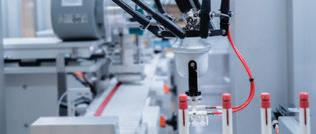
pe.show/527
41, University Drive - 18940 Newtown, PA, US stevanatogroup.com
